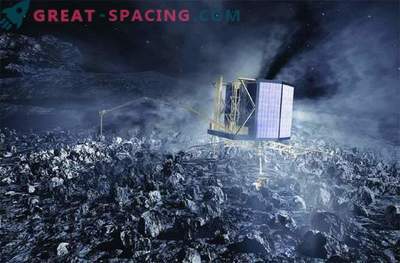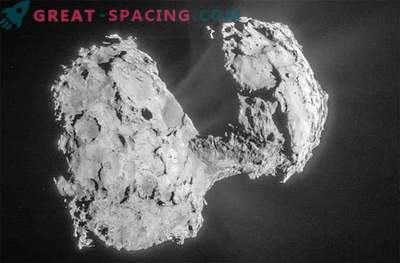
A comet consisting of two parts, like 67P, is able to form after a catastrophic collision of larger objects. Such attacks could occur at a late stage of development of our system. That is, comet 67P may be much younger than previously thought. New data came from computer models.
Scientists decided to investigate what happens after the collision of two large cometary nuclei. Calculations have shown that a significant part of the material accumulates on many smaller bodies. Newly created objects have different sizes and shapes. Among them are many elongated bodies consisting of two parts, which we see in comet 67P / Churyumov-Gerasimenko.
Surprisingly, in such catastrophic collisions, only a small part of the material falls under heat and compression. Then the material is thrown away and is unlikely to participate in the formation of smaller bodies. On the opposite side of the comet, volatile substances can withstand even powerful impacts.
Therefore, a new generation of comets is endowed with low density and a huge amount of volatile substances. This led to the idea that the 67P appeared after a strong late collision and does not necessarily have to relate to the early phase of development of our system, as they used to think.
Impact at a speed of several km / s
Earlier studies said that the 67P could not get its dual structure 4.5 billion years ago. The analysis also shows that the weak point between the two cometary parts is not able to withstand several billion years of flight, and the object itself appeared as a result of a “gentle” collision.
Simulation of comet collisions
The team examined what happens when two bodies collide with different sizes at different angles at a speed of 20-3000 m / s. Modeling shows that small fragments merge into larger elements for hours and days after impact. The final form is often the result of combining two or more large bodies colliding at low speeds.
Mysterious Structure
The simulations show that during the days and weeks small fragments continue to accumulate on a larger basis. The material can be flattened when falling on the surface, due to which a layered structure is formed.
In addition, at this stage, large blocks are accumulated, creating cavities, which then are able to develop into large-scale holes. Such geological structures are seen by the Rosette mission on comet 67P. This again confirms the idea that a particular object is much younger than previously thought.











































